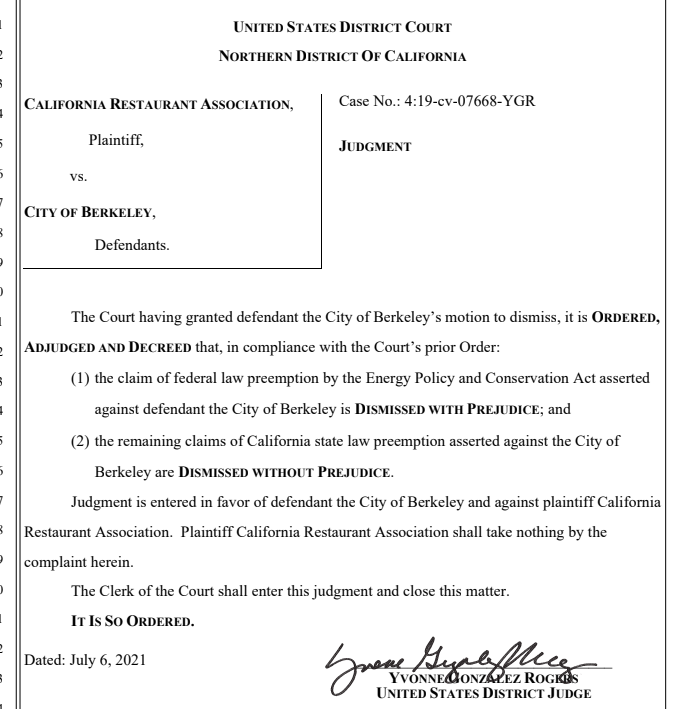 On June 20, 2023, the Spanish Supreme Court handed down its final ruling in the case of Greenpeace v. Spain II, widely known as the trial for climate (“el juicio por el clima”). The decision, formally communicated to the parties on July 27, marks a pivotal moment in climate litigation. In this case, environmental and human rights organizations, including Greenpeace and Oxfam (“the plaintiffs”), had taken legal action against the Government of Spain, alleging inadequate action on climate change. The plaintiffs argued that the National Energy and Climate Plan 2021-2030 (PNIEC)—a key planning document that sets out how Spain will contribute to the achievement of greenhouse gas (GHG) mitigation objectives established at the European Union (EU) level—fell short of the ambitious targets required to meet the temperature goals set by the Paris Agreement.
On June 20, 2023, the Spanish Supreme Court handed down its final ruling in the case of Greenpeace v. Spain II, widely known as the trial for climate (“el juicio por el clima”). The decision, formally communicated to the parties on July 27, marks a pivotal moment in climate litigation. In this case, environmental and human rights organizations, including Greenpeace and Oxfam (“the plaintiffs”), had taken legal action against the Government of Spain, alleging inadequate action on climate change. The plaintiffs argued that the National Energy and Climate Plan 2021-2030 (PNIEC)—a key planning document that sets out how Spain will contribute to the achievement of greenhouse gas (GHG) mitigation objectives established at the European Union (EU) level—fell short of the ambitious targets required to meet the temperature goals set by the Paris Agreement.
However, the Supreme Court found that the Spanish Government had complied with the Paris Agreement and the EU legislation. This blog post analyzes the Supreme Court’s decision and its implications for climate litigation efforts in Spain and beyond. It delves into the arguments presented by both parties, examines the Court’s rationale, and explores the significance of this ruling in the context of international climate commitments.
Background of Spanish Climate Policy
In 2016, the EU ratified the Paris Agreement, which calls on Parties to submit their National Determined Contributions (NDCs) every five years. The EU presents the NDC as one Party (Regulation (EU) 2018/842). Under Annex 1 of the EU Regulation, by 2030, Spain must have reduced its GHG emissions by 37.7% compared to 2005. On 2018, the EU also passed Regulation (EU) 2018/1999 of the European Parliament and of the Council of 11 December 2018 on the Governance of the Energy Union and Climate Action (EU Climate Governance Regulation), the mechanism by which the EU intends to comply with the goals set under the Paris Agreement by imposing Member States the obligation to draft national integrated national energy and climate plans for the approval of the EU Commission, which must include the targets of the Regulation on Annual GHG emissions.
EU NDC and European Green Deal
In 2020, the EU submitted its NDCs before the UNFCCC, on behalf of the EU and its Member States, containing a target of 55% reduction in GHG emissions below 1990 levels by 2030, updating its 2015 commitment of 40% reduction. This target is an overarching EU target and not a target set for each Member State (i.e., the contributions are intra-EU by each member state, but the EU acts as one party before the Paris Agreement). Climate Policy Radar considers this target insufficient based on a fair share assessment.
Following the EU’s lead with the approval of the European Green Deal, Spain has produced a new framework to address climate change, including strategies, plans, and laws. The most relevant efforts include Spain’s ratification of the Paris Agreement in 2017, the approval of the Circular Economy Strategy, the Long-Term Decarbonization Strategy 2050, the National Energy and Climate Plan 2021-2030 (PNIEC) and Law 7/2021 on Climate Change and Energy Transition. The PNIEC and the Law on Climate Change include a target of GHG emission reduction of 23% by 2030 compared to 1990. For an overview of climate governance in the context of Spain’s federal system, see here. For all climate laws related to Spain, see here.
Alignment with EU Policy
Spain’s climate policy and regulation have aligned with the EU’s since its accession to the Union in 1986. This congruence stems from the fact that matters pertaining to environmental, energy, and climate change actions have fallen under the jurisdiction of the EU, as stipulated by its founding treaties. As a Member State, Spain must adhere to policies and regulations emanating from EU institutions, seamlessly integrating them into its legal framework. Simultaneously, Spain must ensure its domestically approved policies and regulations conform to the EU-level standards.
The Case
Filing of Greenpeace v. Spain I
On December 15, 2020, the plaintiffs filed a first lawsuit before the Supreme Court (Greenpeace v. Spain I), alleging that Spain had failed to produce the PNIEC with 2030 climate targets, violating European law (Regulation (EU) 2018/1999, on the Governance of the Energy Union and Climate Action), and their obligations under the Paris Agreement. According to EU regulations, Spain should have approved a comprehensive PNIEC by December 2019, including climate mitigation goals for 2030 and a Long-Term Decarbonization Strategy for 2050. A year after the deadline, the plan had yet to be approved. The plaintiffs argued that the government’s inaction on climate change was due to its failure to adopt these essential instruments and regulations. Furthermore, the draft plan being debated at the time contained a 23% reduction target for GHG emissions, which plaintiffs argued did not align with the long-term goals of the Paris Agreement.
Adoption of New Policies
The situation changed when Spain adopted the Decarbonization Strategy and the PNIEC, the policy documents at the core of the plaintiffs’ claim of climate inaction. Based on these new policy documents, the State Attorney subsequently filed motions to dismiss the plaintiff’s claims concerning the Long-Term Strategy (which the plaintiffs agreed with) and then, after the PNIEC was adopted, to dismiss the entire case for lack of subject matter jurisdiction. In June 2021, the Supreme Court rejected the defendant’s motion since the claims were broader than simply seeking the PNIEC’s adoption. Instead, the plaintiffs sought an order that the Plan must be more ambitious than what had been approved.
Filing of Greenpeace v. Spain II
On May 28, 2021, the plaintiffs filed a second case challenging the newly adopted PNIEC (Greenpeace v. Spain II). The plaintiffs argued that reducing GHG emissions by 23% compared to 1990 levels by 2030 was insufficient to meet the 1.5º C objective of the Paris Agreement. Therefore, they requested the Supreme Court to declare parts of the PNIEC that didn’t meet the criteria null. On March 7, 2022, the Supreme Court decided that Greenpeace v. Spain I and Greenpeace v. Spain II would be jointly deliberated, given the close subject matter connection.
Greenpeace v. Spain II Decision
Fast forward to June 2023, and the Supreme Court’s final ruling on Greenpeace v. Spain II emerges. The court ruled in favor of the Spanish Government and against the plaintiffs’ claims. The decision reflects the court’s view that Spain’s regulatory actions, despite the concerns raised by the plaintiffs, are aligned with the Paris Agreement and in compliance with the EU commitments and regulations. The 30-page decision can be divided into two parts: (1) the Court’s holding on the formal defects in adopting the PNIEC and (2) the Court’s analysis of the substantial defect of the PNIEC concerning the emission reduction target of 23%.
Formal defects in the PNIEC adoption: the environmental assessment and the lack of multilevel climate dialogue
The environmental assessment of the PNIEC was carried out after the plan was drafted and sent to the EU Commission for approval
The plaintiffs argued that the Spanish government skipped vital steps when it adopted the PNIEC, resulting in the plan’s nullity. Specifically, the plaintiffs alleged that the environmental assessment (EA) of the PNIEC (a requirement for approval of the plan) was deficient because (i) the EA was not carried out until after the EU Commission approved the PNIEC and (ii) the Environmental Study (required for the EA) only contemplated two alternative actions: alternative 0 (i.e., not to approve the plan) and alternative 1 (i.e., to set a 23% emission reduction for 2030).
While the Court agreed that the EA was “irregularly” carried out, it dismissed the plaintiffs’ claim of a formal defect. A plan can only be considered null if the defect is of sufficient seriousness, which the Court found was not the case. Had the PNIEC been approved without any EA, the formal defect would have been severe enough to nullify the plan. But the mere fact that the EA occurred after approval of the PNEIC was approved by the EU Commission did not render it null.
Regarding the alternatives considered in the Environmental Study, the Court noted that the Ministry for the Ecological Transition oversaw drafting the plan and bringing it to the Council of Ministers for its approval, meaning that it has the discretion to approve the plans according to the law. Thus, the Court found that it is not for the environmental administration to introduce other targets or alternatives during the EA. Given this, the Supreme Court dismissed the plaintiffs’ request on formal defects.
The process for approval of the PNIEC did not include a multilevel climate and energy dialogue
The Supreme Court found that the multilevel climate and energy dialogue was not carried out, violating article 11 of the EU Climate Governance Regulation. That article requires Member States to implement a platform for dialogue according to national rules, in which local authorities, civil society organizations, the business community, investors, other relevant stakeholders, and the general public can actively engage and discuss the achievement of the Union’s climate-neutrality objective. This requirement differs from public participation in making the PNIEC (art. 10 of the Regulation) since a multilevel dialogue involves a broader range of stakeholders than just the “general public.” Despite agreeing with the plaintiffs, the Court pointed out that the PNIEC cannot be declared null, given the complexity of creating a platform for the multilevel climate dialogue (which would later be partially included in the Spanish Law Against Climate Change).
Furthermore, the Court found that the PNIEC could not be declared null because the EU Climate Governance Regulation does not mandate a specific time for its creation and the efforts of Spain to include the participation of different stakeholders and the fact that since 2019 the Government launched a platform open to dialogue on the future Spanish Climate and Energy Framework; all within the urgent time frame imposed for the approval of the PNIEC, as Spain was already out of the deadline to comply with the Climate Governance Regulation.
Substantial defect of the PNIEC: inadequate mitigation objectives
Alignment of Spanish Policies with Human Rights Law and International Commitments
The plaintiffs argued that the GHG emission reduction goals set in the PNIEC are not aligned with Spain’s commitments under the Paris Agreement. The plaintiffs’ rationale lies in the large body of scientific and technical studies, included in the plaintiffs’ lawsuit, and documents that conclude that an emission reduction target of at least 55% by 2030 (instead of the current 23% commitment) is required to avoid the catastrophic impacts of climate change. This obligation is based on the human rights protected by the European Convention of Human Rights (i.e., right to life and right to health). The plaintiffs also argued that the Supreme Court is competent to impose an increase to 55% reduction as a target on the Administration.
Alignment with EU Policies
The Court refuted the plaintiffs arguments, which would mean, in its view, that Spain has not fulfilled its commitment as a Paris Agreement signatory and bring into question the EU’s fulfillment of its own commitments. The Court found that the Paris Agreement’s long-term temperature reduction goals are not directly binding on Spain. Rather, Spain and other signatories have only a procedural obligation to submit their NDCs to the UNFCCC every five years. Since the EU has submitted the NDCs on behalf of all Member States, Spain has complied with this commitment. The Court further clarified that the Paris Agreement included commitments, not obligations, as the plaintiff claimed. These commitments are indeterminate and vague, as they do not impose criteria for their accomplishment, which are imposed at the EU level.
Separation of Powers Argument
Moreover, the Court declared that it is not competent to nullify the targets adopted in the PNIEC as the impact of their eventual review and invalidation of targets of the PNIEC would implicitly revoke a wide variety of other national policies and regulations, including several laws that emanate from the legislative power in exercising its constitutional competencies. Moreover, the nullity declaration would also interfere with the constitutional competencies granted to the executive power, which decides on the government’s internal and external policies. The Court went as far as to suggest that a declaration of nullity of the emission reduction target would mean, de facto, the decision of the Spanish State to renegotiate its commitments under the Paris Agreement and to de-harmonize its policy with the regulations and commitments of the EU, to which Spain belongs to and has delegated specific competences (as any other Member State) in climate matters.
The Court acknowledged that in light of the evidence presented by the plaintiffs, it is crucial to intensify climate change mitigation measures. However, given the “indeterminate” commitments under the Paris Agreement, and since the EU approved the PNIEC, the PNIEC cannot be declared null.
Reference to Carvalho case
The Court further highlighted the efforts and legislative action of the EU in mitigating climate change, and cited the ruling of the European Court of Justice of 25 March 2021 in Armando Carvalho and others v. The EU Parliament and the Council, which rejected a challenge to the EU Climate Governance Regulation, to conclude that said ruling also limited the powers of the court to a legality control of the regulations adopted by the EU in the exercise of its powers.
In short, the Court reasoned that Spain must adhere to the provisions of the Paris Agreement through the EU’s mechanisms and regulations. Should the Court find Spain in non-compliance with the Paris Agreement, it would, in essence, indirectly suggest a lack of compliance on the part of the EU—an area outside its jurisdiction. Simultaneously, it would place the onus on the Spanish Government to modify the PNIEC, which could be interpreted as disregarding the EU’s authority. The EU has delineated obligatory emission reduction targets for each Member State within its jurisdiction and endorsed the PNIEC based on these binding targets.
Analysis
No Analysis of Merit
The Court failed to analyze the merits of Spain’s mitigation commitments substantially, instead dismissing the case on purely formal grounds. Furthermore, the Court missed an opportunity to analyze the vast climate science that is now available or engage with similar cases across Europe. Notwithstanding, the upcoming ruling of the ECHR on the case KlimaSeniorinnen v Switzerland could have direct implications for Spain, potentially calling on all EU countries to adopt the necessary legislative framework to enforce the commitments of the Paris Agreement.
Assessment of International Climate Policies at the National Level
The case exemplifies the intricate interplay between climate litigation, international agreements, and the evolving legal landscape. The court’s ruling echoes points made by jurists in other countries, which have dismissed challenges to national climate policies on separation of powers grounds. Indeed, courts in the United States, Canada, Scotland, and the United Kingdom have found that the judiciary cannot weigh in on specific policies adopted by the executive government, which has discretion over implementing climate policies. Courts in other countries have ruled differently, however. Courts in Germany, the Netherlands, and Brazil, for example, have found that the judiciary is vital in balancing the functions of the three branches and protecting individual autonomy as a crucial element.
In Urgenda Foundation v. the Netherlands, the Dutch Supreme Court found that the grave dangers posed by the climate crisis on human rights mandate a State’s duty of due diligence requiring substantiation that emissions reduction measures were responsible, which the Dutch State had failed to demonstrate. Based on different grounds, the German Constitutional Court found in Neubauer et al. v. Germany that the country’s climate law was unequally offloading emissions reductions into the future, and the judiciary was obligated to concretize constitutional norms to ensure that certain boundaries were protected. In other examples of systemic mitigation cases, apex courts in Colombia, Nepal, Brazil, and a first-instance court in Belgium have determined that the respective State must adopt more ambitious GHG mitigation efforts or implement its existing commitments (in the case of Brazil and Belgium) to protect human rights and freedoms.
Current situation of the Spanish PNIEC
While the judicial process was still ongoing, the government started to review the GHG emission targets of the PNIEC, in compliance with article 14 of the EU, which mandates that Member States submit an updated version of their PNIECs by June 30, 2024. For the review, it launched a public consultation with a new draft plan, including a proposed 32% reduction target by 2030 based on 1990 levels and a 55% reduction target by 2030 based on 2005 levels. The decision to review the PNIEC aligns with several proposals at the EU level for more ambitious climate targets, such as the EU Climate Law (Regulation 2021/1119) or the packages “Fit for 55” or “REPower EU.” As such, while the plaintiffs may have lost the trial for climate, Spain is nevertheless increasing its ambition on climate change in line with EU targets and IPPC recommendations.





